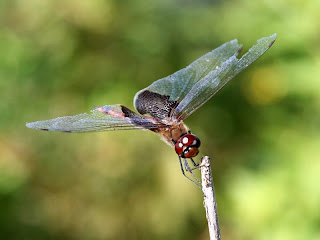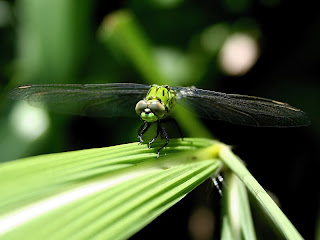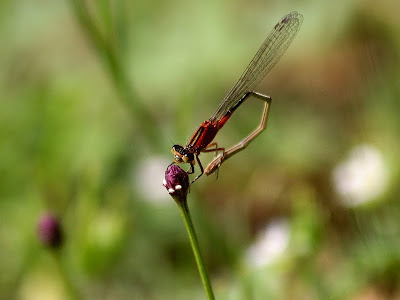 When I first bought my camera, I had little luck photographing dragonflies. They like to land on water plants offshore, and the zoom feature of my first two lenses couldn't get me close enough for a good shot. Here in Florida, television news anchors love to report that another brain-sucking amoeba has traveled up a careless swimmer's nose, landing the poor soul in an irreversible coma, so walking into lake water to bridge the distance between me and the subject was so not an option.
When I first bought my camera, I had little luck photographing dragonflies. They like to land on water plants offshore, and the zoom feature of my first two lenses couldn't get me close enough for a good shot. Here in Florida, television news anchors love to report that another brain-sucking amoeba has traveled up a careless swimmer's nose, landing the poor soul in an irreversible coma, so walking into lake water to bridge the distance between me and the subject was so not an option. Any dragonfly photo I took in 2005 was just plain lucky. I always assumed my subjects were either newly emerged or dying, their pristine or tattered wings the proof. Their vulnerability gave them no choice but to tolerate my proximity. But my newest lens, a 300 mm, allows me to sit at the water's edge and bring the water plants and their perchers right to me, dry and comfortable on the shore. With the magic of magnification, getting close enough to a dragonfly is no longer the challenge:
Any dragonfly photo I took in 2005 was just plain lucky. I always assumed my subjects were either newly emerged or dying, their pristine or tattered wings the proof. Their vulnerability gave them no choice but to tolerate my proximity. But my newest lens, a 300 mm, allows me to sit at the water's edge and bring the water plants and their perchers right to me, dry and comfortable on the shore. With the magic of magnification, getting close enough to a dragonfly is no longer the challenge: 

The ability to bridge the physical distance does not, however, automatically make a good picture. Dragonflies have sparkling wings, big shiny eyes, and other smooth, light-reflecting body parts. As we have had a record-setting stretch of cloudless, rain-free days, the blinding sun and polished subjects often make nothing but ugly glare.
I am willing to shoot 50 pictures of the same insect, though, and with a little luck, one of every three or four bugs will reward me with a good picture. Down at Lake Como, the closest body of water to the house, the majority of dragonflies are male blue dashers. The females, I've learned, remain inland until they are ready to mate, so it's a real frat house down at the water as the males aerial battle for perches. They wait for a willing female to enter their "house" where they have a "bed," a water territory, they are defending.

Patrolling the land between the shore and the busy road that the lake interrupts are the aptly-named Carolina saddlebags. Notice the "saddlebag" spots on the hind wings:

I have spotted an occasional Halloween pennant close to water:

If I hunt carefully near the water's edge, I can find the damselflies, the second type of Odonata, veritable needles in the grass.

I try to keep the sun at my back; I try to use the shade of a cypress tree as a natural hood for the lens to reduce glare. I try to frame the shot so that a bright orange road construction sign isn't the background for the dragonfly. But a willing subject perched for his portrait can so inspire my finger to mash the shutter button that the little I know about good photography is quickly forgotten, and I arrive home with a bunch of useless crap.


